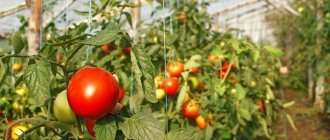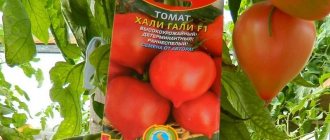It is rarely possible to cook vegetables immediately after purchasing or removing the stalk. How to store tomatoes without freezing and canning? Experienced housewives know exactly what tricks to use to achieve the perfect result, and why tomatoes should not be stored in the refrigerator. Many problems arise when choosing where to store green tomatoes so that they turn red faster. All it takes is a little effort.
Varieties for long-term storage
To ensure that the harvest is stored for a long time, those varieties that are characterized by high shelf life are selected for planting. Tomatoes are not washed; heavily soiled ones are wiped with a soft cloth, trying not to spoil the skin.
Experienced vegetable growers harvest slightly unripe tomatoes of the following varieties:
- De Barao is a mid-season tomato, the height of the bush reaches 3 m. The fruits are oblong, of different colors - from yellow to brown.
- San Marzano is a variety with dense, juicy fruits of bright red color, plum-shaped, weighing up to 140 g.
- Rio Grande is a mid-season variety with high yield.
There are special varieties and hybrids bred for long-term storage:
- Giraffe is a variety that reaches a height of 1.2 m. It is a late-ripening variety and is cultivated in open ground and under film covers. The fruits are stored until the end of spring.
- Long Keeper is a late-ripening variety, tomatoes reach 450 g. They are stored fresh until spring.
- Masterpiece-1 is a late-ripening, low-growing hybrid; its bush grows up to 65 cm. Red, flat fruits weighing about 200 g are stored until March.
Which tomatoes can be stored for a long time?
Not every tomato can last a long time after being picked. Late-ripening species are suitable for winter storage. Thanks to the work of breeders, a special gene was discovered that is responsible for delayed ripening, and the resulting hybrid varieties tolerate transportation better and can be stored for a month or more.
The very first hybrid suitable for winter storage is the Giraffe. Over time, scientists have grown a large number of varieties with varying shelf life:
| 2–3 months | 3–5 months | 6–7 months |
| Oak | New Year | Giraffe |
| Japanese crab | Red stone | Long keeper |
| Dominator | Rio Grande | Christmas Eve |
Before storing tomatoes, they must undergo preliminary preparation, as this will increase the chance of successful and long-term storage.
How to properly harvest tomatoes for storage
The harvest is harvested before night frosts, since frozen fruits will not be stored for long. Basic collection rules:
- tomatoes are harvested during the day, when there is no morning dew on them;
- to extend shelf life, the collected fruits are sorted;
- choose only ripe vegetables and fruits ripened to milky ripeness;
- All collected tomatoes are wiped with alcohol for disinfection.
Storage conditions and location
To preserve tomatoes for a long time, you must adhere to temperature and humidity conditions. +8–10 degrees are considered optimal, with an air humidity of 80%.
Tomatoes are very sensitive to sudden changes in temperature, and if the thermal balance is disturbed, they become lethargic and lose their unforgettable aroma.
The location chosen for storage also plays an important role. Any dark room is suitable for this: a basement, a pantry, a closed vegetable compartment in the refrigerator, or the space under the bed.
How to store the harvest
Fleshy, sugary tomatoes are the worst to store, as they quickly begin to ferment and become unsuitable for consumption. Slightly unripe tomatoes stay fresh for 2-3 days longer than ripe ones because their flesh is still hard. Overripe fruits are eaten immediately, as they do not last long.
On a note . Regardless of the variety, tomatoes grown outdoors are better preserved than those grown in greenhouses.
How to store tomatoes in a cellar or basement
The suitable temperature for maintaining the freshness of tomatoes is +10-15°C, so the best place to store picked tomatoes is a basement or cellar. In the cellar, tomatoes are placed in wooden boxes in layers, separating the layers with paper. If possible, each tomato is wrapped in paper wrapper. Do not put more than three layers in boxes, otherwise the bottom row will deteriorate from the weight of the top ones.
If there is no cellar, then vegetables are stored on the floor - for example, in a pantry. Unripe tomatoes are left at room temperature, where they ripen over time.
Features of storage on the balcony
A suitable place to store ripe tomatoes is a balcony if the air temperature does not exceed +15°C. Tomatoes are stored there in the same way as in a cellar or basement: they are laid in layers, each layer covered with cloth or paper. The boxes themselves are also covered with fabric to protect them from sunlight.
How to store fresh tomatoes in jars
Canning is a method of long-term storage. In jars, tomatoes remain usable for 4-6 months.
Ripe tomatoes are washed and dried, then placed in a three-liter sterilized jar. Pour 3-4 tbsp. l. alcohol, cover with a nylon lid and shake so that all the tomatoes are well wet. Then a thread soaked in alcohol is placed in the middle and set on fire from the outside. When the alcohol starts to burn, immediately cover the jar with a metal lid.
On a note. For long-term storage, jars are placed in a cool, dark place.
In boxes
Tomatoes are kept in wooden boxes with slits to allow oxygen to reach them. The boxes are covered with gauze or cotton cloth, but not with a lid. There should be no foreign odors in the container. To protect the tomatoes from moisture, dry hay is placed at the bottom.
In the sawdust
To keep tomatoes in boxes longer, use sawdust. If the crop is still slightly unripe, it is placed in boxes, if possible in wooden ones, with the top to the top (where the stalk was - this is the top). Under each layer, paper is placed and sawdust is poured, which will absorb moisture and protect the fruits from rot.
To make this storage method more effective, the boxes are placed in a dry and dark place at an air temperature of no more than +10-15°C. It is better to store tomatoes in the cellar, basement or on the balcony if the side is not sunny. The box is covered with gauze or paper.
Indoor storage
Ripe tomatoes are poorly stored at temperatures higher than +22°C. Because tomatoes contain a lot of sugar and juice, warm conditions create a favorable environment for fermentation. Fleshy fruits with a thin peel are stored at room temperature for no more than 2-3 days. If the tomato has a thick shell and dense pulp, then the vegetables will be stored for up to 6-7 days.
Important! To avoid poisoning from stale products, tomatoes should not be stored at room conditions for longer than this period.
In paper
If the fruits are in newspaper or paper, they will be stored for a long time not only in the refrigerator, but also in a box or basket. The main thing is not to put a large number of tomatoes on top of each other; 1-2 layers will be enough.
Storing in a pan
For long-term storage, tomatoes are pickled in a saucepan. To do this, cut half of the tomatoes into equal parts. Place a layer of chopped vegetables in a pan, sprinkle with salt, then a layer of whole ones. And so on several times until the container is completely filled.
On a note. Regardless of the method you choose, inspect your inventory periodically. If a tomato begins to spoil, remove it immediately so that it does not infect others.
In jars with mustard
The tomatoes are thoroughly washed with hot water and dried. Pour 2 tbsp into a sterilized jar. l. mustard powder. Tomatoes are placed in it and each layer is sprinkled with mustard. A three-liter jar should take no more than 7 tbsp. l. powder. The jar is sealed and stored in a cool place.
How to preserve fresh tomatoes in a jar
You can store more than just money in a bank. You and I will put fresh tomatoes there. They will still be fresh when you take them out.
Method 1
You will need clean sterilized jars, tomatoes and any vegetable oil. Place pre-washed and completely dried tomatoes in a jar and fill to the top with oil. The oil should cover the tomatoes completely, even with a small margin. Roll up with a metal lid (also sterile) and forget about them until the New Year.
Method 2
The jars must again be sterilized, the tomatoes washed, dried and placed in them. However, instead of oil this time, pour a vinegar-salt solution over the fruit. To prepare it, add 1 part vinegar and salt to 8 parts water. Roll up the jars.
Cold storage
Where is the best place to store ripe tomatoes? Using regular newspaper, tomatoes can be stored in the refrigerator for up to two weeks. Each vegetable is wrapped in a paper bundle or combined in three pieces into an envelope. The goal is to keep the tomatoes from getting soggy. The optimal place to store tomatoes in the refrigerator is the bottom shelf for vegetables. The newspaper is changed periodically, and the shelf in the refrigerator is wiped dry.
On a note . Do not store tomatoes in a closed plastic bag, as they can quickly spoil due to condensation.
But when stored in the refrigerator, tomatoes lose their fresh taste. The volatile substances they contain, which give the aroma and familiar taste, do not withstand low temperatures and are destroyed.
Where to store tomatoes in an apartment
It is more difficult to preserve the tomato harvest in an apartment for a long time, but it is also possible. What places are suitable for storage:
- Loggia. On a glazed loggia or balcony, the temperature, depending on the weather, can fluctuate from 10°C and above. Tomatoes should like these conditions. Just remember to protect them from the sun, which speeds up the ripening of the fruit.
- Floor under the bed. Not 10°C, like on the loggia, but still cooler than in the kitchen cabinets.
- Under the bathroom. However, with this storage method, monitor the humidity level and ventilate the bathroom more often.
Those with a cool, dark pantry are especially lucky. Tomatoes will feel quite comfortable on the lower shelves or on the floor. Not a wine cellar, of course, but better than in other places.
Storing Processed Tomatoes
Tomatoes are not only stored fresh. Heat-treated, long-storable fruits are used for food. In terms of taste, they are not inferior to fresh vegetables.
Canned, dried and dried fruits last much longer and do not require special storage conditions:
- Hermetically sealed canned tomatoes can be stored for a long time even at room temperature. Such blanks last up to a year.
- If vegetables are fermented or pickled and kept under a nylon lid, they can be stored for up to six months.
- Dried tomatoes are stored in the same way as sun-dried ones. They are placed in bags made of natural fabrics or in paper bags to provide oxygen access to the vegetables and prevent the penetration of dust and insects. Dried tomatoes are stored in a dry and dark place.
How to store homemade tomato preparations
The main recommendation for homemade preparations is storage in a dark and cool place. A cellar, closed balcony or refrigerator is suitable for these purposes.
Drying tomatoes for the winter - a delicacy from the Mediterranean
Juicy and aromatic sun-dried tomatoes will be a pleasant addition to the table during the winter cold. They are first dried in an electric dryer and then stored in olive oil with spices.
Ingredients:
- tomatoes – 4 kg;
- sea salt – 1.5 tsp;
- “Italian herbs” spices – 2 tsp;
- garlic – 1.5 heads;
- olive oil – 250 ml.
Preparation:
- cut the tomatoes in half, remove the stem;
- select the seeds using a knife;
- Place the tomatoes in a heated electric dryer in rows;
- salt and sprinkle Italian herbs on each layer on the trays;
- leave to dry at +70°C for 10-12 hours;
- change the trays every 2-3 hours for better drying;
- When the tomatoes are completely dry, remove them from the electric dryer;
- cut the garlic into small pieces;
- Place sun-dried tomatoes, chopped garlic in pre-sterilized glass jars and add olive oil.
Cover the resulting delicacy with a lid and put it in a dark, cool place.
Important! For drying, it is better to choose dense, not very watery varieties. Preference is given to fruits 4-5 cm long.
Low temperature storage
Tomatoes are suitable for storage in the freezer. To ensure their long-term preservation, it is important to carefully select tomatoes. They should not show signs of rot or mechanical damage.
Tomatoes are suitable for storage in the freezer
It is preferable to choose medium-sized vegetables, with loose skin and elastic pulp. Before placing in the freezer, each fruit must be thoroughly washed and wiped dry with a paper towel.
You can freeze both whole and chopped tomatoes.
Whole fruits
The advantage of this harvesting method is a longer savings period. Freezing does not affect the taste of the fruit in any way. They are suitable for consumption within 12 months.
Tomatoes without signs of rotting or damage are thoroughly washed, wiped dry with napkins and laid out in one layer on a stand. Vegetables should not be stacked on top of each other.
In this case, they will not be wrinkled. The tray is placed in the freezer at maximum freezing mode. After the fruits are completely frozen, they are placed in a special freezing bag.
Chopped tomatoes
This method requires a lot of time compared to saving whole fruits. However, the advantage is that tomatoes can be added as a dressing without chopping or thawing.
Before adding the product, there is no need to select perfectly whole tomatoes and get rid of the peel. The fruits are washed under water and cut into small slices.
Chopped tomatoes
In the same way you need to prepare bell peppers and herbs. The products are ground in a meat grinder and mixed thoroughly. There is no need to salt the resulting mass.
The mixture is placed in silicone baking molds of any shape. Chopped tomatoes are sent to the freezer.
After complete freezing, the product is removed from the molds and placed in special bags for storing vegetables in the freezer. The resulting tablets can be added to borscht or as a salad dressing without defrosting.
General recommendations
It is not recommended to buy fruits for storage in supermarkets. It is better to take those grown in the garden or buy them at the market.
Advice from experienced housewives:
- To keep the fruits longer, they are removed along with the stalk.
- Vegetables damaged by rot or parasites should not be stored in the same container as whole vegetables.
- Tomatoes are stored in a cool, dark place - in the basement, pantry, under a table, sofa or bed.
- Tomatoes are periodically checked for rot. The spoiled ones are thrown away so that the rest do not start to rot.
- Vegetables are stored strictly with the stalk facing up, since the skin around it is tender, and under the weight of the tomatoes it can crack, and then the tomato will begin to deteriorate.
- For long-term storage, each fruit is wrapped in paper and placed in boxes or baskets in no more than 1-2 rows.
- Do not store vegetables in a plastic bag, since it will not be possible to keep tomatoes fresh for a long time due to high humidity.
Method with alcohol
Take jars, tomatoes, a few tablespoons of alcohol, and a thick thread for the wick. So, we sterilize the jars, put the tomatoes in there, pour 2 tablespoons of alcohol, cover with a lid, swirl the jar a little so that the alcohol saturates each vegetable. We light the wick and lower it into the jar, immediately roll the lids tightly. Now we know how to keep tomatoes fresh using jars and improvised means.
There is another opinion on this matter. Tomatoes will last longer if they are not supplied with oxygen. Therefore, simply rolling them into jars without any additives is possible and necessary. But before this, you need to boil each tomato for 2 minutes, dry it and simply lower them, loosely, into jars, roll them up with a lid, and open them in winter. It must be stored in the cellar.
What should you store tomatoes with?
The storage temperature of tomatoes plays an important role, but fresh vegetables should not be stored next to the following fruits:
- Apricots.
- Apples.
- Bananas.
- Pears.
Ethylene gas is actively released from these products. It causes increased ripening and spoilage of nearby vegetables. You should also not keep tomatoes next to carrots. In such a duet, the orange beauty will be the injured party. Its taste will turn from sweet to bitter. Do not store tomatoes together with cabbage or celery. Because of this proximity, the taste of the tomato will become significantly worse.
Necessary conditions for keeping vegetables fresh
There are some rules for storing fresh tomatoes. The requirements must be complied with; this will determine how long they will remain fresh and edible.
Storage temperature
Storage temperature depends on the degree of ripeness of the fruit. Traditionally, the following requirements are presented:
- ripe - 0-2 degrees;
- white - 8-10 degrees;
- green - 12-14 degrees;
- brown - 4-6 degrees.
Failure to comply with the conditions can lead to rapid spoilage of the fruit. Also, you should not allow temperature swings.
And others
An equally important factor is humidity, it should be 80%. These are the conditions that are considered optimal for tomatoes. A lower value can cause the tomato skin to dry out and rot to appear.
In addition, the vegetable crop should be kept away from sunlight; light has an extremely negative effect on the fruit.
Ripening
Tomatoes of varying degrees of ripeness without damage are suitable for ripening. This process will allow you to extend the period of eating fresh tomatoes for another couple of months.
The speed of ripening and shelf life directly depend on the temperature conditions in the place where stocks are stored. Regulating the temperature in the storage will speed up or slow down the ripening of vegetables.
Long ripening
Long-term ripening of tomatoes occurs at +10...+12 degrees. The fruits should be placed in one layer.
It is important to organize the optimal level of environmental humidity. The indicator should be within 85%. A higher level will speed up the process of rotting vegetables. Lack of moisture leads to sagging and dry tomatoes.
If it is important to protect the fruits for as long as possible, then the crop is inspected daily.
All tomatoes that begin to turn red are placed in another container, since these vegetables emit a significant amount of ethylene, which will accelerate the ripening of other specimens.
The disadvantage of this storage method is the appearance over time of a large number of spoiled, rotten tomatoes.
Fast ripening
Rapid ripening of vegetables is carried out in a well-ventilated storage without signs of dampness at a temperature range of +20...+24 degrees.
Tomatoes sorted by size are laid out in wooden or plastic boxes in several layers. The stalk of each fruit should be placed at the top.
Be sure to read:
How to store vegetables and fruits for a long time
The top of the vegetables should be covered with newspapers or towels to prevent sunlight from reaching the crop.
The ripening process can be significantly accelerated . For this purpose, hay is placed between the tomatoes. You can put several red fruits, ripe apples, pears, and bananas in the boxes. In such conditions, the process of full ripening will take no more than 8 days.
Keeping stocks at a temperature of about +30 degrees promotes even faster ripening. The disadvantage of this method is that the tomatoes lose their elasticity. They become very soft, and yellow spots appear in the stalk area.
Ripening on the bushes
There are several ways to ripen green fruits on whole dug up plants.
During the first, the tomatoes are dug up, after which each bush is hung in a dry room with sufficient ventilation with the root facing up.
The second method involves digging up the plants by the roots and placing them in a wooden box on the veranda or greenhouse.
How to help fruits ripen
If you need green tomatoes picked from the bush to ripen faster, the following trick will help. Thanks to her, the fruits will ripen in a week.
Green fruits should be placed in a well-lit place. The temperature should be above 25 degrees. These conditions will help the vegetables ripen quickly without spoiling.
In an apartment, green tomatoes can be laid out directly on the windowsill. The sun's rays and warmth will do their job.











